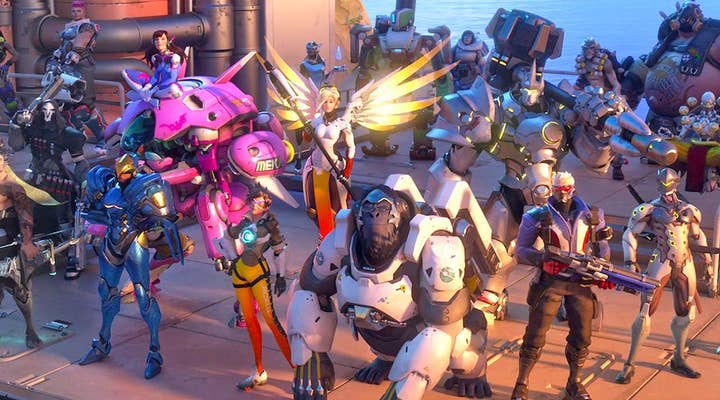Rami Ismail’s leading 10 ideas on making it through the indiepocalypse
In fact, the indiepocalypse has been extensively discussed over the past few years. The idea that there are so many independent video games freely available on the market makes it unsustainable.
This was extensively covered in a session by late Vlambeer co-founder and independent industry expert Rami Ismail at this year’s Reboot Develop Blue conference in Croatia.
Ismail saw that the number of independent video games had significantly expanded over the previous few years, making it extremely difficult to get launched.
The idea behind [the indiepocalypse] is that independent video games will eventually cease to exist as a market segment if this pattern and growing supply persist. “I’ve seen various market segments die out, like Flash and Facebook video games, but here’s the crucial point: If you’re an independent developer, you sort of don’t stand a chance of creating a successful video game. Making an Among United States, a Minecraft, or a Hades has quite few alternatives.
What then can we do? What is the service? You stand out, you persevere, and you succeed. How are you going to do it in 2023?
- 1. Understand threats
- 2. Do not go after the marketplace
- 3. Check your organization case
- 4. Presume failure
- 5. Do not intend expensive
- 6. Construct your brand name
- 7. Accept genuineness
- 8. Prevent the apparent
- 9. Fail much faster
- 10. Be luckier
- 11. There is no indiepocalypse
1. Understand dangers
Ismail noticed that there are primarily only two ways to run any service: either you lower your risk or you raise your chance. One of them will be more well-liked even if you do both.
“If you have infinite funds, I urge you to go improve your odds. Risks can be tolerated. Your biggest obstacles when starting out are probably that you haven’t provided anything, that you don’t have any money, and that you don’t have any experience. You then need to figure out how to lessen your threats.
“Simply stating where you can deliver something is the best way to reduce your threat.”
Ismail advised studios to start by creating a cheap video game. He said that Radical Fishing, the original Flash version of what would later become Vlambeer’s biggest hit, Ridiculous Fishing, cost roughly $60 and was created on school computers.
Ismail estimated that the budget for independent films would be $70,000 today, though he did not specify what this would contain. He was conscious of the fact that certain publishers will only consider video games with a budget of $1 million or more.
“Simply stating where you can deliver something is the best way to decrease your threat. The problem with budget plans that cost $70,000 or more is that you need to get someone to pay for it because if you pay for it all yourself, you’ll be investing three years of your life and money that probably won’t work.
When I talk about risk, I mean that you should get as much of the risk away from you as possible as quickly as you can.
2. Do not chase after the marketplace
Ismail urged designers to take a different approach after expressing his frustration at the sheer number of independent developers who claim to be creating roguelikes. While building a business model around other people’s success can seem sensible, it can be challenging to take on well-known blockbusters and predict what the next big thing will be.
Ismail told the audience that while things move in waves in the video game business, they are also oddly unpredictable, and that Overwatch’s success in 2016 as a hero shooter could not have predicted that the biggest blockbuster two years later would be a narrative-driven God of War.
“This has no pattern or reason. Did anyone foresee that [Among Us], a video game about little, squishy characters betraying one another on a spaceport station, would likely be the distinguishing title of the preceding five independent video games? that it would be the subject of political discussions? Of course not.
Ismail added that the larger companies that can compete in the market can only do so because they have access to a “incredible quantity of information,” for which they pay tens of millions of dollars. Even if independent studios think they have identified a market niche, other studios have probably done the same.
There is no gap in the market, he said, warning against chasing after it.
“If you’re running a business, you want to look at the market and understand what’s going on there. The market cannot direct your creative process.

3. Evaluate your company case
Indie authors must review their business case because they will most likely be pitching publishers and financiers for funding. Ismail offered the advice to start your pitch with “the five publishers you despise one of the most” for this.
Don’t go to your favoured publications because you want to give them the greatest possible pitch. Find the five people you really don’t like, and then just pitch them. Take the money if they say, “Yes, we’ll give you $10 million.” Make the video game, screw it, and release it. Find the five things you dislike, then practise your pitch on those.
“Next, make a pitch to the five that you like considerably more. Many independent authors submit their worst proposal to the publishers they prefer.
There is no space in the market; therefore, you shouldn’t pursue it.
Even if you self-publish, there are ways to assess your business case. Create a video game teaser page and start talking about the situation with your potential audience.
Ismail advised, “Put it out there, test it, and repeat.” “Trying to do the ideal variation of getting out of eviction never ever works.”
He advised studios seeking publisher funding or aid to stay out of the public until all other options have been exhausted.
“If you approach 100 publishers and they all say, ‘This is the worst trash I’ve ever seen,’ then you approach an audience and they enjoy it, they won’t understand why 100 publishers rejected it. They won’t be interested if you try a Kickstarter, stop working, and then approach a publisher.
4. Presume failure
Ismail claimed that the only healthy way to manage any business is to operate with the assumption that your video game would ultimately be a financial failure. This should also guide your decision-making process for your organisation.
When seeking funding from a publisher, be sure to request enough to cover the costs of creating and shipping the game as well as maintaining the studio’s operations for three to six months so that you may prepare to pitch your next project.
“Even if your video game is successful, you won’t get paid right away. It takes between three and six months for it to hit your checking account. You need to make sure you have enough runway at the conclusion of your video game to begin working on anything fresh.
5. Do not intend too expensive
Ismail saw that most of the studios he is familiar with adapt to the challenge they face. The problem is that, depending on your abilities, the difficulty will only get worse.
He gave the example of his former studio, Vlambeer. The group was never bigger than seven people, and most of the time it was between two and five. They merely created video games that 2 to 5 people could have created.

“We agreed at the beginning that we would never grow, and it worked out really well since the video games we were creating reflected what we may do.
He went on to explain that it has a snowball effect, with new hires causing larger video games causing brand-new hires, and so on. “As soon as you work with another artist, you then need to feed that artist, which suggests you require to make somewhat larger video games with slightly larger spending plans,” he said.
Simply create better video games, he advised. “You don’t have to get bigger to do it. Your team is developing, gaining knowledge, and becoming more accustomed to one another. In the end, your group starts getting considerably better without having to expand.
“Growth needs to be purposeful, and if you keep getting closer to the barrier, you’ll lose control of it. Don’t raise the difficulty; instead, raise it a little below it and stay there. Don’t expand your studio beyond that. You can expand a little if you want to build bigger video games, but keep in mind that any growth could lead to further expansion.
6. Develop your brand name
While some people may object to the term “brand name,” Ismail explained that video game designers need to establish a human connection with their audience and create an identity that sets them apart. He tasked developers with imagining two friends discussing their video games in the future. What did you want them to say?
Additionally, he emphasised that this does not imply developers must continue creating games in the same genre. All of Vlambeer’s games were wildly different from one another, but Ismail claimed that the studio became most well-known for its usage of firearms and screenshake.
“When people played those video games, they would immediately recognise them as Vlambeer productions. Our audience could relate to them because they had a certain style of humour, were dark and weird, and had screenshake.
Publishers’ focus on marketing their own brands is a hurdle in this situation. Ismail suggested that attendees give Hotline Miami or the creators of Cult of the Lamb a call. Few in the area could, but many knew the publisher was Devolver Digital because the publisher has actually done such a great job developing its brand. People also used Raw Fury and Annapurna Interactive as examples; even though they don’t actually develop video games, people are aware of the genres of games they release.
“We’re making a video game that’s best for Annapurna,” so many people have pitched to me, is one of the major things I find really upsetting. Why are you developing a video game just for one company? What happens if they say no? build your video game because you want to build it, not because a publisher will publish it. There is a crucial element there, and if you accomplish that, you build your brand name.
Ismail mentioned that your video games’ brand name is not nearly as important. Building a brand involves many different factors, including community management, audience engagement, market communication, and connection-making.
“The developer’s fingerprint is on every video game,”
Not just your studio, but also you, are to blame. Be excellent if you please interesting people. Talk to certain people. Instead of just talking to them because you think they might be useful to you, talk to them because they’re people.
“As you advance in this field, you can occasionally help one another out. Not because you have to, but rather because they’re good people and we want to see decent people flourish in this market. Celebrate success when someone achieves it. Do you realise how challenging it is to be successful? Celebrate each person’s triumphs. And when people cease working, make a quick phone call.
Consistency is essential to building a brand, Ismail added, emphasising once more that this does not imply sameness but rather demonstrating that people can rely on you for anything, whether it be you as a person, your video games, or your studio.
7. Welcome genuineness
Ismail said that in order to be seen as trustworthy, a person must be genuine. Even though designers have a lot in common, they all have different life experiences.
“Every video game has the fingerprint of its developer,” he said.
He gave the example of the video game dry run, noting that many of them are produced in the United States and have players invade foreign countries or entire worlds in the hopes of liberating them while suffering little to no repercussions. He claimed that only American culture would produce video games of that kind.
In contrast, Ismail cited games like This War of Mine from Polish developer 11 Bit Studios, a video game about surviving the effects of war, and Spec Ops: The Line from German studio Yager, a game about the hurt, remorse, and sympathy of war.
“Those 2 video games were just so different from one another because they were real. The groups didn’t say, “We want to practise, what are the common characteristics of war?” No, they used their own life experience as well as that of their grandparents to inform their actions. Something exciting, something new. You’ll create video games that look and play like video games if you start looking at video games as your inspiration.
“Creativity is an outcome of who you are,” he concluded. It’s not a conscious attempt to set oneself apart. Many people have the view, “How can I be innovative by being different?” Cut that out. What do you naturally do? What is it that demands your attention, whether you want to or not? The more you allow that, the harder it will be for others to compete with you, and the more chances you’ll need to distinguish out.
8. Prevent the apparent
Ismail advised against using obvious video game elements. Because most individuals will draw the same conclusions when faced with similar problems, as was previously mentioned, waves of similar video games are frequently released. You can come up with something truly original by relating the obvious notions to your life and considering the deeper undercurrents and connections.
Ismail mentioned advice he received at a video game jam in the past: drop the first three ideas. He gave the example that if a group was given the task of creating a video game in the “termination” genre, many people would immediately start thinking about ideas involving dinosaurs or meteors.

9. Fail quicker
Ismail has observed that some studios take a year or longer to realise their video game won’t function as they had intended. He expressed concern about the value of prototyping because of this, but he also urged designers to consider more carefully about their perceptions of a model.
One designer showed him a model that was basically a bunch of scribbled out documents that crashed every 30 seconds, the man said. But you can learn there’s a lot to love in that 30 seconds. Other independents show me designs that resemble finished video games. They offered a basic menu. You only need a reset button in case it crashes.
He recommended designers to “stop working much faster,” to “stop being great video game designers,” and to create models that could look ridiculous but let you test whether the central idea of your work would appeal to players. Ismail agreed that some designers could object to this, but he likened it to asking an artist for sketches and hearing them complain that the sketches won’t look good or asking a narrative designer for a half-page draught and hearing them complain that there won’t be room for history.
“It makes no difference. Get it moving, don’t worry about getting it right. Make it really terrible, fast.
“You’ve screwed up,” he said, “if you spend a year and a half dealing with something before you define where you can ask someone if it’s good. You want to be able to approach [someone] three or six months into the project and ask, “Is this fascinating?” after showing them the first concept, the model, five mockups of what it will look like, the story, the budget, and the timeframe. Many publishers will ask you to submit a vertical work; do you understand what they mean by that? It suggests that they are at least debating it.
10. Be luckier
Finally, the most important advice is to be luckier, Ismail grinned. “Stop being so unfortunate, please! Even if you get everything right, video game development is really just a coin toss.
“Get it going, don’t get it right. Make it really terrible, fast.
He identified his own line of work. He took time away from his job to write the second of the two letters that Dutch trainees must mail to universities in order to enrol. This meant that he worked for a merchant for a year, learning sales techniques, and then started school the following year — coincidentally, the same year as Vlambeer co-founder Jan Willem Nijman.
He said, “My profession is entirely built on the fact that I excel at mailing stuff.
“A large portion of what happens in video games is luck; very little of it is about getting it right or hitting the mark. Any anybody who tells you otherwise is lying. There are some people who will never be fortunate, and you might be one of them. And then there are those who, like you, will strike it lucky on their first attempt. You are powerless to control this; all you can do is your best. Consistency and reaching a position where you can deliver are the only things you can control. As long as you can, keep doing that to lessen your risk. Up until the moment where you no longer need to, you decrease your threat. You continue working your day job until you have enough money to stop.
11. There is no indiepocalypse
Ismail mentioned at the end of his speech that he truly thinks the indiepocalypse concept is “bullshit.” The misconception that the quantity of video games released each year will continue to rise indefinitely is what is causing concerns about the indie industry. Ismail countered that it won’t. There will be more designers, but some of them will quit or shut shop.
The levelling. He said, “There’s a ceiling. “What’s the purpose about a saturated market? We’ve already hit it. There are currently far more video games available than players have time to play. The market is complete; we’re done.
“More independent video game designers will quit their jobs than before. This is also true given that there are more successful video game developers than ever. There are more people who just keep making video games.
He noted that it holds true for any other form of home entertainment in which creators can independently create and distribute their work. Checking your expectations and focusing on the task at hand are the keys to success.
You won’t become the next Notch or Among United States, he said, and if that’s your goal, you’ll always give up. “If you simply want to create the next thing, deliver the crucial components, and then the next, and the next, and you build that consistency, and you build that brand, and you construct that audience, and you get it funded by another person so even if you stop working, you can attempt once more… That is how you survive the independent media apocalypse.
More GamesIndustry.biz Academy guides to Selling Games
Our guides cover all aspects of the development and publishing process, whether you’re a rookie video game creator looking to start a new job or a seasoned industry professional:
- The surprise expenses of indie video game advancement
- Is it a great time to be an indie dev?
- The supreme guide to offering your indie video game
- More guides about offering video games

























